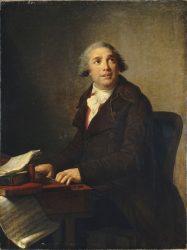
[ad_1]
 United Kingdom New Chamber Opera – Paisiello, La Frascatana (The Lady from Frascati): Soloists, The Band of Devices / Steven Devine (conductor). New School, Oxford, 28.6.2023. (CR)
United Kingdom New Chamber Opera – Paisiello, La Frascatana (The Lady from Frascati): Soloists, The Band of Devices / Steven Devine (conductor). New School, Oxford, 28.6.2023. (CR)

Manufacturing:
Director – Michael Burden
Solid:
Violante – Emily Brown Gibson
Don Fabrizio – Thomas Humphreys
Nardone – Henry Ross
Cavaliere Giocondo – Magnus Walker
Donna Stella – Lara Marie Müller
Lisetta – Kate Semmens
Pagnotta – Thomas Niesser
As an opera buffa Giovanni Paisiello’s La Frascatana (1774) options the common character varieties and plot construction of the style with three males in search of the attentions of Violante (the eponymous woman from Frascati) or at the very least her dowry. They embody Magnus Walker’s breezy and cheery Cavaliere Giocondo – already betrothed to Lara Marie Müller’s boldly characterised Donna Stella together with her generally fearsome flights of coloratura and ‘turtle dove’ simile aria mocking the conventions of opera seria; and Violante’s ward, Don Fabrizio, acted with a consummate sense of buffoonery and delivered with admirably clear, commanding diction by Thomas Humphreys.
Violante holds her personal towards their advances in Emily Brown Gibson’s contemporary, spontaneous efficiency, together with her considerably lighter, even flirtatious florid vocal strains. She loves Nardone as an alternative, given a reasonably easy-going, ingenuous account right here by Henry Ross, although he additionally contrives some trenchant exchanges with Fabrizio. As all the time with such operas, the servants aren’t any dupes, though right here they play comparatively much less half than in others in advancing a collection of methods or disguises to make sure that the correct woman and boy are matched up. Thomas Niesser performs an amiable, barely hapless, Pagnotta (Giocondo’s attendant) whereas
Kate Semmens is the charmingly sly Lisetta, the waitress on the inn the place the motion is about, who takes a shine to the Cavaliere.
With its collection of energetic numbers and ensembles, in addition to hectic finales for 2 of its three acts which construct up fairly a dramatic head of steam, the opera stands up effectively in addition to Mozart’s immortal comedian masterpieces which, in any case, weren’t to comply with till a little bit over a decade after Paisiello’s composition. The country background of its state of affairs isn’t unusual in this sort of theatrical work – Violante’s deceased father was a rich gardener, and her beloved Nardone is a sheep proprietor who disguises himself as a lowly shepherd for a lot of the plot – nevertheless it’s an intriguing coincidence that it ought to parallel the self-esteem of the ‘fake gardener’ in Mozart’s nearly contemporaneous opera La finta giardiniera.
Steven Devine leads The Band of Devices in an ebullient efficiency of the rating, marking the galant magnificence of plenty of arias with their sustained melodiousness, whereas additionally responding sharply to the quickfire dialogue or adjustments of circumstance within the ensembles, as an illustration in some pointedly niggling accompaniments to Nardone’s sparring with Fabrizio. The usually chaotic finale to Act I, through which the characters all repeatedly specific their concern of ‘catastrophe’ is onomatopoeically rendered with the intentionally unmusical truly fizzling out on some cadences on that structural watchword. Maybe probably the most notable scene of the opera is that in Act II, set in a darkish tower the place the irate Fabrizio has imprisoned Violante to take away her from Nardone, however the latter and Pagnotta comically imitate his phrases, unseen, to discombobulate him with what he thinks are echoes. Such a scene certainly parodies the rising pattern at the moment for gothic horror tales, in addition to the format of some liturgical works with an identical echo impact exploiting the acoustics of the areas through which they had been carried out, particularly in San Marco, Venice (town the place this opera was premiered), most famously in Monteverdi’s ‘Audi coelum’ from his Vespers. That scene comes off notably effectively in New School’s ante-chapel the place this efficiency passed off, moderately than outdoors, owing to unsure climate, the place the music can really reverberate and the singers cover behind the pillars within the constructing to play their trick. With Simon Rees’s agreeable English translation, total the performers efficiently spotlight the opera’s levity and good spirits.
Curtis Rogers
[ad_2]